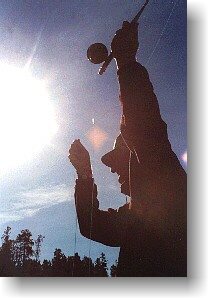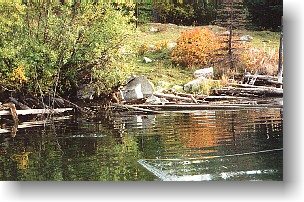
Fly Lines & Extra Long Leaders
article and photos by Gordon Honey
 Selecting the
correct fly line for specific angling circumstances, can be the key to a day
of success or one filled with frustration and long faces. Your fly line is
critical in how you present your chosen fly to not only the correct depth
but in a manner that will induce our finned quarry into eating it. Selecting the
correct fly line for specific angling circumstances, can be the key to a day
of success or one filled with frustration and long faces. Your fly line is
critical in how you present your chosen fly to not only the correct depth
but in a manner that will induce our finned quarry into eating it.
As a new fly fisher, fly line selection can be very confusing, not only the
terminology, weight, foreword, double taper, level, specialty lines such as
shooting heads Bass Bug taper, Salmon taper, Steeled taper, etc. etc.!! Floating
lines, sink tips in a multitude of options, full sink lines, again in different
sink rates, i.e., intermediate slow, fast deep water express, etc., etc.,
etc.!!!
You should begin with two line types - a full floating and an intermediate
line both in WF (Weight Foreword) as they are much easier to cast. The line
you chose must match your rod if you have a 6 weight rod then chose a 6 weight
line so that the two are matched and can work together when casting. This
weight ratio for rods and lines was agreed upon years ago by all manufacturers.
The floating line will allow you to fish with floating files referred to as
dry flies, it will also allow you to use various nymphs, referred to as wet
flies (remember 95% of the trout's food source is sub surface), floating lines
allow you to fish in shallow water situations and by lengthening your leaders
up to 15 - 25 feet, deeper water. (Floating lines and long leaders get a little
crazy so we will deal with that scenario below). The intermediate line will
allow you to fish water from say 3 ft. to 12 ft. The beauty of an intermediate
line is that it maintains your fly in the critical zone in a consistent manner,
allowing you to keep your fly in the fish's face as long as possible.
Don't let all of this confuse you, prior to purchasing a
line, spend some time researching so that you develop a good
understanding. Drop by your favorite shop, ask lots of
questions and pick up brochures from the manufactures, they
are well presented and easy to understand.
 Long Leader's
When and Why? Long Leader's
When and Why?
The use of long leader's, 16 to 25, appears to be a Kamloops phenomenon.
Angler's in the U.S. shake their heads in wonder and ask the obvious question;
"How on earth do you cast them? My stock answer, "Very, very carefully!
The long leader application allows us to fish nymphs in relatively deep water,
with a floating line. We do this for two main reasons, it is more enjoyable
to not only cast floating lines, but to also play fish. Floating lines are
much lighter and because they are on the surface they create less drag when
a fish makes long runs. The number one reason for the floating line - long
leaders combination is to allow you to present a nymph at an appropriate depth,
for a longer period of time. This applies especially when chironomid fishing.
The floating line - long leader chironomid technique again appears to be
a Kamloops creation. Our interior lakes have tremendous chironomid hatches
especially in April and May. It is without a doubt the most abundant and prolonged
of all invertebrate hatches and has become almost an obsession with many fly
fishers. As chironomids have no ability to swim their vertical migration to
the surface is a tedious trip to say the least. The trout following a long
winter under the ice, relish chironomid hatches and will literally gorge themselves
on these tiny tidbits. Imagine if you will, hundreds of thousands of pupae
wiggling their way to the surface, trout simply cruise at a chosen depth,
opening and closing their mouths, as they inhale these tasty morsels without,
as nature demands, expending any energy.
For the fly fisher this provides us with a tremendous opportunity using the
following technique: First, if you can, visually determine at what depth the
fish are intercepting the pupae, cast your floating line across the breeze,
so you can cross drift your fly into the feeding trout. Use a pre-determined
countdown method to put your fly at the proper depth, your long leader now
allows you to present your pattern to depths in excess of 20 feet. Now, begins
a painstakingly slow retrieve, a figure eight or hand twist method is best
. Your floating line is now acting as a bobber suspending your long leader
and fly at the correct depth in combination with your ultra slow retrieve.
Watch your line like a hawk and raise your rod tip at the slightest movement,
remembering that the fish are cruising, slowly opening and closing their mouths
on the pupae, therefor the take can be very subtle. This combination of floating
line and long leader can also work well for fishing Mayfly nymphs and sedge
pupas as they swim quite rapidly to the surface, as well as Leeches in the
spring and fall, and a great many different presentations. Casting long leaders
can at first be difficult, slow everything down and throw wider loops, classic
tight loops only lead to a multitude of wind knots and a great deal of wasted
fishing time repairing and untangling leaders!
Floating lines and long leaders - a great combination, thanks to the ingenuity
of Kamloops fly fishers.
Gordon Honey gordon@flyfishingservices.com
|




 Selecting the
correct fly line for specific angling circumstances, can be the key to a day
of success or one filled with frustration and long faces. Your fly line is
critical in how you present your chosen fly to not only the correct depth
but in a manner that will induce our finned quarry into eating it.
Selecting the
correct fly line for specific angling circumstances, can be the key to a day
of success or one filled with frustration and long faces. Your fly line is
critical in how you present your chosen fly to not only the correct depth
but in a manner that will induce our finned quarry into eating it. Long Leader's
When and Why?
Long Leader's
When and Why?